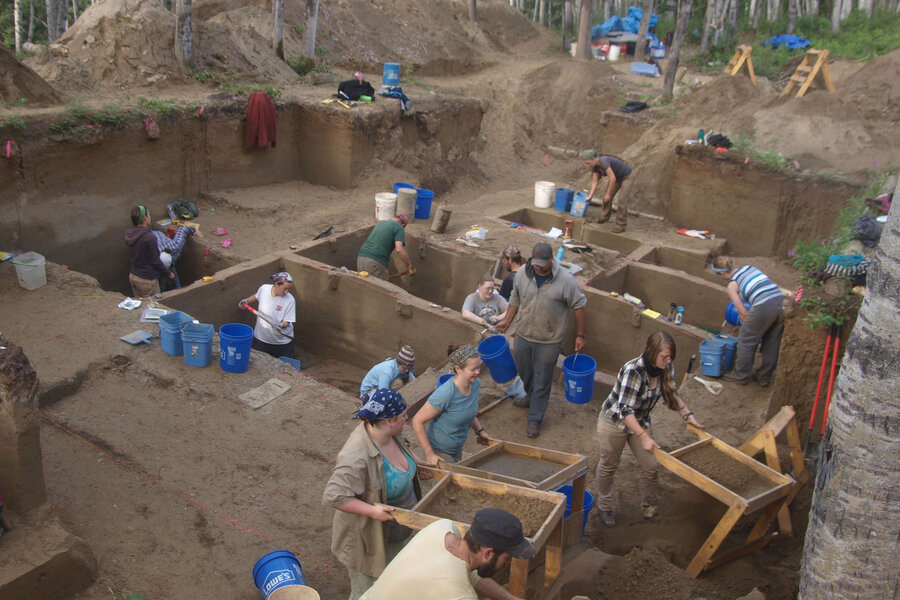What ancient babies reveal about ice-age Americans' travels
Loading...
Scientist have long debated how humans originally arrived in the Americas. The prominent idea has been that a sort of land bridge formed during the last ice age and people migrated from Asia.
But people may not have just waltzed over the land bridge and spread across the Americas. Instead, they may have settled in northern Alaska for a while first.
And the newest clues come from a surprising place: babies.
Scientists have sequenced the mitochondrial DNA from two infants found buried together at an Alaskan campsite some 11,500 years ago in a paper published Monday in the journal Proceedings of the National Academy of Sciences.
That ancient DNA revealed that the little ones did not share a mother. In fact, they are related to two different lineages of Native Americans found elsewhere in the Americas.
It’s that genetic diversity that supports the “Beringian standstill model” that says humans may have spent as many as 10,000 years in the area around the Bering Strait known as Beringia before spreading south through the Americas.
“These infants are the earliest human remains in northern North America, and they carry distinctly Native American lineages,” study senior author and University of Utah anthropology professor Dennis O'Rourke said in a news release.
“It supports the Beringian standstill theory in that if [the infants] represent a population that descended from the earlier Beringian population, it helps confirm the extent of genetic diversity in that source population,” Professor O'Rourke said. “You don’t see any of these lineages that are distinctly Native American in Asia, even Siberia, so there had to be a period of isolation for these distinctive Native American lineages to have evolved away from their Asian ancestors. We believe that was in Beringia.”
Some 25,000 years ago the last ice age saw low sea levels. That revealed a sort of land bridge stretching from Siberia to Alaska where the Bering Strait is today.
People would have migrated across this newly revealed land into what is present-day Alaska. According to the Beringian standstill model, these people would have had to settle where they arrived, in what is called Beringia, because any other path was blocked by gigantic glaciers.
In that scenario, it wasn’t until the glaciers began to retreat, some 15,000 years ago, that these people were able to migrate further.
But these babies died some 11,500 years ago, after the Beringian population would have begun to disperse.
Ripan Malhi, of the University of Illinois, and colleagues proposed the Bergingian standstill model in 2007, but Dr. Malhi isn’t so sure this new evidence is conclusive.
“It’s valuable information,” he told The New York Times, “but it’s a little bit late to be extremely informative to let us know if the Beringian Standstill hypothesis holds.”
Unfortunately, most of Beringia is now under water, limiting potential for more archeological finds.
But O’Rourke thinks these specimens are still valuable. The community that buried them “may well be a remnant of that original Beringian group. It may give us a snapshot of that earlier time,” he told the Times.
The baby bodies were placed on red ocher and surrounded by hunting darts made from antlers, the Times reports. Found beneath the burial of a seemingly cremated 3-year-old, these specimens were discovered during a dig at the Upward Sun River site, an ancient campsite about 50 miles southeast of Fairbanks, Alaska.
The infants neither shared a mother nor a later Native American lineage, so the researchers are puzzled as to why they were buried together.
“It’s not common to find infants buried together that are not related maternally,” O'Rourke said in the news release. “It raises questions about the social structure and mortuary practices of these early people.” Perhaps the babies shared a father.
One thing is for sure from this research, said Ted Goebel, an archeologist at Texas A&M University. Humans walked their way into the Americas.
“It nails it shut that without question,” he told The Salt Lake Tribune. “The earliest Native Americans came from the Bering land bridge.”








